|
|
 |
|
November 27, 2009
I would like to weigh in with my opinion on the controversy regarding the washing of sparkling wine glasses recently raised by my colleague, WRO editor Michael Franz. [See yesterday’s posting by clicking on “More WRO Wine Blog” at the bottom of this section.] It seems that my other WRO colleague, Michael Apstein, favors washing wine glasses with detergent and then thoroughly rinsing the glasses. Franz, on the other hand, never uses soap when washing his sparkling wine glasses.
My position is somewhere in-between, although I’m closer to Franz’s opinion. Soap in any form is anathema for wine/Champagne glasses, for all the reasons Franz lists. Apstein can rinse all he wants, a la Lady MacBeth washing her hands, but that sneaky soap residue is almost impossible to remove. My official position, since we published Wine for Dummies in 1995, where I write extensively about washing wine glasses, is that simple supermarket washing soda (Arm & Hammer is a leading brand) is best for washing one’s fine wine glasses (by hand, not in the dishwasher). Washing soda leaves absolutely no residue, and leaves the glasses sparkling and germ-free.
I must admit that we put our inexpensive, everyday glasses in the dishwasher, but I would advise that you wash them separately in hot water, with no detergent.
Washing soda is inexpensive, and can be found in the detergent aisle in all supermarkets....
Posted by Ed McCarthy at 4:58 PM
|
|
November 26, 2009
Statistics show that millions of Americans drink wine on just a few days each year, and Thanksgiving is a big day for these very  occasional imbibers. If you are among them, I'd certainly like to see you enjoy wine much more frequently in the future, but for now we need to get you through today with a positive experience. Here are a few pointers that may help you, and perhaps one or two that might come as news even to more experienced wine lovers: occasional imbibers. If you are among them, I'd certainly like to see you enjoy wine much more frequently in the future, but for now we need to get you through today with a positive experience. Here are a few pointers that may help you, and perhaps one or two that might come as news even to more experienced wine lovers:
--If your wine glasses have been sitting in a cupboard for a month, they've surely picked up a little dust even if they don't look dusty, and some of these particles can produce undesirable aromas or flavors that can seriously screw up your wine. Be sure to rinse your glasses out with hot water and dry them with a lint-free dish towel.
--If you'll be serving sparkling wine or Champagne, these glasses need  to be washed differently. As beer lovers know, soap residue kills bubbles, and whereas a flat beer is a disappointment, a flat glass of Champagne is a catastrophe. If you are prepared to rinse endlessly and take your chances (like my WRO colleague Michael Apstein), then go for it. However, my mantra is: No soap, ever! You can remove fingerprints and lipstick from the outside of glasses when perfectly inverted with a lightly soapy sponge, but never let any soap into the interior, which should only be rinsed with very hot water. Dish towels can retain soap residues, so air-dry sparkling glasses or use paper towels. If one of your guests thinks it is “icky” that you don't use soap on your sparkling wine glasses, solve the problem by striking that person from the guest list. to be washed differently. As beer lovers know, soap residue kills bubbles, and whereas a flat beer is a disappointment, a flat glass of Champagne is a catastrophe. If you are prepared to rinse endlessly and take your chances (like my WRO colleague Michael Apstein), then go for it. However, my mantra is: No soap, ever! You can remove fingerprints and lipstick from the outside of glasses when perfectly inverted with a lightly soapy sponge, but never let any soap into the interior, which should only be rinsed with very hot water. Dish towels can retain soap residues, so air-dry sparkling glasses or use paper towels. If one of your guests thinks it is “icky” that you don't use soap on your sparkling wine glasses, solve the problem by striking that person from the guest list.
--If you'll be serving sparkling wine (and if you’ve got it, you should damned well serve it!) please take note: Don't put a damper on your dinner by blasting someone with the cork. This is serious: A Champagne cork can really do a number on your eyeball, and since the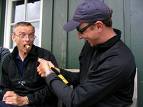 hospital emergency room will already be packed with inept turkey carvers, you'll be there for hours if you suffer a mishap when opening your bubbly by the ballistic method. So: Keep constant and very firm downward pressure on the cork, even when unwinding the wire cage, which will require exactly six twists. Keep the cage on the cork, as it will enhance your grip. Ease the cork from the bottle by grasping it firmly as you twist the base of the bottle from side to side. A nearly inaudible result is what you want, with the faintest "pfffffffft" showing that you know what you're doing. hospital emergency room will already be packed with inept turkey carvers, you'll be there for hours if you suffer a mishap when opening your bubbly by the ballistic method. So: Keep constant and very firm downward pressure on the cork, even when unwinding the wire cage, which will require exactly six twists. Keep the cage on the cork, as it will enhance your grip. Ease the cork from the bottle by grasping it firmly as you twist the base of the bottle from side to side. A nearly inaudible result is what you want, with the faintest "pfffffffft" showing that you know what you're doing.
--Pay attention to serving temperature! Most Americans are guilty of serving their whites too cold and their reds too warm. Wines pulled directly from refrigerators--much less ice buckets--are typically so cold  that aromas are suppressed and flavors flattened. Similarly, the old rule of thumb about serving reds at room temperature has led millions of people to mishandle their wine. The rule made sense when coined by some guy in the 18th century, but only because he lived in an English manor house without central heat. Reds lack focus and seem overly alcoholic at 72 degrees, and are much better at 62. So, stick your reds into the fridge for 20 minutes and pull your whites out of if for 20 minutes before cracking into them. that aromas are suppressed and flavors flattened. Similarly, the old rule of thumb about serving reds at room temperature has led millions of people to mishandle their wine. The rule made sense when coined by some guy in the 18th century, but only because he lived in an English manor house without central heat. Reds lack focus and seem overly alcoholic at 72 degrees, and are much better at 62. So, stick your reds into the fridge for 20 minutes and pull your whites out of if for 20 minutes before cracking into them.
--Don't overfill glasses when serving wine at the table. Sparkling wines can be filled to slightly above halfway, since they look much better with that fill level, and you don't want your guests thinking you are cheap on a day when you are supposed to be celebrating bounty. However, glasses for table wine should never be more than half full. An overfilled glass has no open space to collect the wine's aromas, which are absolutely crucial for appreciating it fully.
--Last but not least: When you've gone through all of this and are finally ready to wine and dine, just relax and enjoy this wonderful beverage. It is famously difficult to get a perfect wine to harmonize with everything involved in Thanksgiving dinner, and you shouldn't be shamed if your choice isn't perfect with everything on the plate. After all, this meal brings wine-pairing experts to their knees. And if some self-appointed expert at your table makes a nasty crack about your choice, don't dignify his (it will surely be a he) comment with a reply. Just roll your eyes. And know that everyone else at the table is on your side! involved in Thanksgiving dinner, and you shouldn't be shamed if your choice isn't perfect with everything on the plate. After all, this meal brings wine-pairing experts to their knees. And if some self-appointed expert at your table makes a nasty crack about your choice, don't dignify his (it will surely be a he) comment with a reply. Just roll your eyes. And know that everyone else at the table is on your side!
Posted by Michael Franz at 10:42 AM
|
|
November 25, 2009
This is the time of year when wine writers are inevitably called upon to offer wine-pairing recommendations for that all-important Thanksgiving meal. How many more times does it need to be written that Gewurztraminer - Beaujolais - Riesling - Zinfandel - Pinot etc. etc. are the perfect wines for turkey day?
Rather than rehash that tired theme (any more than I just did), I’m going to make anti-recommendations. Here are my picks for what NOT to serve with Thanksgiving dinner.
• Tannic Reds: I don’t care how much you love mouth-drying Cabs and Bordeaux wines, they’re guaranteed to overwhelm the flavors of delicate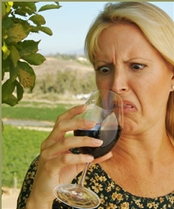 turkey and mashed potatoes -- even with gravy. And I shudder to think of what they’ll taste like with sweet dishes like cranberry sauce and sweet potatoes. Save the tannic reds for a different holiday, like National Beef Day. turkey and mashed potatoes -- even with gravy. And I shudder to think of what they’ll taste like with sweet dishes like cranberry sauce and sweet potatoes. Save the tannic reds for a different holiday, like National Beef Day.
• Trophy Wines: Unless your family members are serious wine geeks, save your best bottles for a smaller affair. Take my family as an example. I’m first-generation Italian, so my relatives wouldn’t let a day pass without drinking at least one glass of vino. But, more likely than not, that vino comes in a gallon jug. To my family, wine is like water -- a daily necessity that doesn’t require analysis or discussion. Just drink it! So why would I bust out my 1998 Brunello for folks who would be just as happy with a tasty-but-not-precious table wine?
• Throw-Away Wines: Not serving your best bottles with Thanksgiving dinner doesn’t mean that you should head straight for the Two-Buck Chuck floor stack at Trader Joe’s. Avoid wines with cutesy animals on the labels, wines under $3 and pretty much anything that’s packaged in a box, or a bottle that holds more than 1.5 liters. That’s not to say that you should never buy those wines for everyday mindless drinking, but holidays call for something more interesting, with more personality in the bottle than on the outer packaging.
• Champagne (with Dessert): Some people love to serve Champagne or other fine sparkling wines at the end of a special meal, but the Brut style just doesn’t cut it with sweet desserts. These wines are just too dry, and the pairing won’t do any favors for the Champagne or your mom’s pumpkin pie. Demi-sec sparklers are another story.
• Oaky Chardonnay: While Chardonnay doesn’t necessarily clash with Thanksgiving fare, this is the holiday meal that really lets alternative whites shine. This is the time to break out of the daily Chard habit and try something different!
Whatever you choose to drink -- or not drink -- this Thanksgiving, here’s wishing you a safe, fun-filled and delicious holiday.
Posted by Tina Caputo at 9:43 AM
|
|
November 24, 2009
[WRO Readers: We'll be publishing Thanksgiving wine recommendations from our WRO contributors in this space almost every day until the holiday--so stay tuned! Michael Franz]
Everybody’s favorite holiday is a time to get together with loved ones and friends to give thanks for what we have. In my case, I usually gather with just a few close family members, and I tap my own cellar for special wines. But I will also recommend more affordable wines that I would buy if I were getting together in a large family/friends setting.
I always begin every festive occasion with Champagne, and Thanksgiving is as festive as it gets. With appetizers and first courses, I start with a good Blanc de Blancs Champagne, such as one from Deutz, Pol Roger, Bruno Paillard, or Louis Roederer; Bruno Paillard’s is particularly dry.
I’ll often go with a second bottle of Champagne to continue with first courses. I particularly recommend Charles Heidsieck’s Brut Reserve, Gosset’s Grande Reserve, or Bollinger’s Special Cuvée.
If I were providing a less expensive option for large gatherings, I’d go with a California brut; the non-vintage Roederer Estate is excellent, and a great buy at under $25. If you plan to begin your Thanksgiving dinner with Italian antipasti, consider Prosecco, a tasty, well-priced bubbly (most under $20) that pairs so well with this food.
For your main course, whether it’s turkey, duck, or pork, I’d go with white Burgundy and red Burgundy; some will prefer the white, others the red, but both match up well. Many decent white and red Burgundies are available for under $35, especially those from the Côte de Beaune. A simple Bourgogne Blanc or Bourgogne Rouge from a top producer, such as Domaine Leflaive or A & P de Villaine, would be excellent.
An alternative to red Burgundy could be a good California Pinot Noir, such as one from Hartford Court, Williams Selyem, or Littorai. These producers--all from Russian River Valley in Sonoma--make outstanding, well-balanced Pinot Noirs that are not overly fruity.
Some of my colleagues will mention Beaujolais, red Zinfandel, Riesling, or Gewürztraminer to accompany turkey, but I don’t think that any of these wines pair well with the bird. But that’s my palate; we’re all different.
I like to end the dinner with tawny port (doesn’t need decanting) or a good Madeira. The Madeira would go especially well with pumpkin pie. The port would be excellent with nuts, cheese, or chocolate.
This column is making me hungry. Happy Thanksgiving!
Posted by Ed McCarthy at 11:45 AM
|
|
November 20, 2009
[WRO Readers: We'll be publishing Thanksgiving wine recommendations from our WRO contributors in this space almost every day until the holiday--so stay tuned! Michael Franz]
While my wife gets to fantasize about a Thanksgiving feast prepared by Thomas Keller (see Marguerite’s 11/18 blog), I’m the one left to schlep the actual wine to the actual meal every year. And as she notes, Thanksgiving in this family is always somewhat chaotic. The get-together alternates between a big country house in McLean, Virginia, and an equally large suburban one in Montclair, New Jersey; but regardless of locale, it usually includes 30 or more people representing three generations. Not everyone is a wine drinker, and I suspect that the glass or two that some people have that day may be just about the only ones they’ll have all year. But there are some others who, if not collectors or connoisseurs, are fairly avid enthusiasts, and so are eager to try what Marguerite and I, the family’s alleged “experts,” bring. The bottom line, then, is that this is a tough crowd to please when it comes to wine. three generations. Not everyone is a wine drinker, and I suspect that the glass or two that some people have that day may be just about the only ones they’ll have all year. But there are some others who, if not collectors or connoisseurs, are fairly avid enthusiasts, and so are eager to try what Marguerite and I, the family’s alleged “experts,” bring. The bottom line, then, is that this is a tough crowd to please when it comes to wine.
Because this family has old New England roots, no one would dare even think about eating anything other than the most traditional sort of Thanksgiving fare. No wild rice risotto with Maine lobster, or turkey leg confit with corn pudding, ala Marguerite’s fantasy. No, we’ll have the whole bird (or given the size of the crowd, probably two), with old-fashioned stuffing (probably Pepperidge Farm), green beans, creamed onions, both cranberry sauce and cranberry jelly, and of course sweet potatoes (yes, those little marshmallows do show up). It’s all very Joy of Cooking and Yankee. And the only rule I have when choosing which wines to bring is that they should be American. It just seems right.
So what am I going to bring this year? Well, a fairly large assortment, 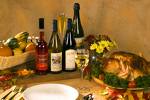 both reds and whites, but representing only a few varietals or types so that no one will get upset about missing anything. For the whites, it’ll be Washington State Riesling and Oregon Pinot Gris; for the reds, California and Oregon Pinot Noir. (In a perfect world, I might want Finger Lakes Riesling and Virginia Viognier, but those wines are difficult to find in Baltimore where I live; and remember, this non-fantasy meal never aims for perfection.) both reds and whites, but representing only a few varietals or types so that no one will get upset about missing anything. For the whites, it’ll be Washington State Riesling and Oregon Pinot Gris; for the reds, California and Oregon Pinot Noir. (In a perfect world, I might want Finger Lakes Riesling and Virginia Viognier, but those wines are difficult to find in Baltimore where I live; and remember, this non-fantasy meal never aims for perfection.)
Why these particular choices? Riesling because, even when vinified dry, its inherent fruitiness should help it appeal to both novice and experienced drinkers. And the renditions from Washington State tend to have enough body or heft not to be overpowered by what we’ll eat. I’ll bring Pinot Gris from all three Pacific states because I think this category is extremely undervalued. The wines tend to have an inherently autumnal character, their fruit flavors echoing apples and especially pears, so they should be great partners for this late November meal. And Pinot Noir? Well, I’ll have to be careful, as far too many American Pinots these days taste hot and heavy, the antithesis of what this varietal classically should be. But when made in a legitimately light, lithe, and silky style, no other American red wine has the versatility to survive the Thanksgiving onslaught.
I’ll be packing a bunch of different examples of Pinot Noir, Pinot Gris,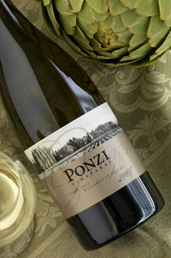 and Riesling in the trunk of the car come Thursday morning. After all, I hear that we’re expecting close to 40 people this year! If, however, we were having a smaller, quieter, less chaotic (but I have to admit, probably less fun) celebration, and I had to bring just one bottle of each, here’s what I’d choose--based on wines I’ve tasted this fall: Seven Hills, Columbia Valley (Washington) Riesling 2008 ($14), Ponzi, Willamette Valley (Oregon) Pinot Gris 2007 ($18), and Saintsbury, Carneros (California) Pinot Noir “Garnet” 2008 ($21). All three are fine wines with which to lift a glass in toast and thanks. and Riesling in the trunk of the car come Thursday morning. After all, I hear that we’re expecting close to 40 people this year! If, however, we were having a smaller, quieter, less chaotic (but I have to admit, probably less fun) celebration, and I had to bring just one bottle of each, here’s what I’d choose--based on wines I’ve tasted this fall: Seven Hills, Columbia Valley (Washington) Riesling 2008 ($14), Ponzi, Willamette Valley (Oregon) Pinot Gris 2007 ($18), and Saintsbury, Carneros (California) Pinot Noir “Garnet” 2008 ($21). All three are fine wines with which to lift a glass in toast and thanks.
Posted by Paul Lukacs at 3:18 PM
|
|
November 18, 2009
[WRO Readers: We'll be publishing Thanksgiving wine recommendations from our WRO contributors in this space almost every day until the holiday--so stay tuned! Michael Franz]
Our family Thanksgiving tradition is generally a chaotic affair that spans two days, four generations, up to 50 people, and more meals than I care to discuss. Needless to say, fine wine isn’t really a consideration in these circumstances. The "wine service" consists mostly of unloading 3 or 4 cases of inexpensive mixed reds, whites and perhaps a few rosés onto tables for guests to grab and pour. To be honest, most of the people attending this event are more concerned about getting to the buffet table while there’s still some crisp skin left on the turkey than about which wine to pair with the mashed potatoes and gravy. And so, with this gastronomic anarchy looming ahead, I’m going to close my eyes now and imagine a different scene … there is candlelight … soft music…a table set for two--no, make that four, or perhaps even six for good conversation and a generous variety of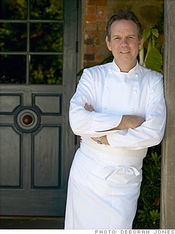 wines. But wait! Is that Thomas Keller I glimpse working in my kitchen? Judging from the mouthwatering aromas wafting towards us, it must be him. wines. But wait! Is that Thomas Keller I glimpse working in my kitchen? Judging from the mouthwatering aromas wafting towards us, it must be him.
We’ll have only American wines--and not all of them from California--at this fantasy feast, to go with the mostly American foods. This Michigan fizz in my glass, for example, made by Larry Mawby, one of America’s premier producers of sparkling wine, is robust enough for the caviar from California’s Sacramento River, and it also has enough zip to suit the Wellfleet oysters on the half shell that are being passed around to the guests. (L. Mawby, Blanc de Noirs Brut; made from 100% Pinot Noir from the Leelanau Peninsula, whole cluster pressed, fermented in stainless steel tanks then blended with reserve wines, and fermented a second time in the bottle and aged en tirage before dégorgement; $23.)
As we sit down to eat, glasses of Willakenzie Pinot Gris are poured. The wine is bright and lively, generous in the mouth and utterly delicious with the first course: wild rice risotto topped by butter-and- lemon drenched chunks of Maine lobster. (Willakenzie Pinot Gris, Willamette Valley, 2008, made entirely in stainless steel, no malolactic, no cork closure, $19). lemon drenched chunks of Maine lobster. (Willakenzie Pinot Gris, Willamette Valley, 2008, made entirely in stainless steel, no malolactic, no cork closure, $19).
Wow, I’ve never turkey leg confit before, but what a splendid idea, especially since it frees up all that white meat that can now be used, as nature intended, in sandwiches. The confit, fabulously unctuous after roasting in duck fat, is nestled up against a bed of tender corn pudding. We’ve got two red wines here to enjoy with the dish, one from each coast. The first is a Barbera from California’s Renwood winery, a medium-bodied wine with a core of fresh fruit and enough tannins to scour away the richness of the confit. (Renwood Barbera, Amador County, 2005, aged in small barrels, $23.) In the second glass is a Cabernet Franc from Barboursville, an outstanding Italian-owned winery in Virginia, which shows sophisticated restraint, with layers of fruit anchored to a backdrop of cedar and vanilla (Barboursville Cabernet Franc Reserve, 2006, aged up to 14 months in new and used French barriques, $23. This wine, incidentally, was a gold medal winner at the 2008 Critics Challenge Wine Competition.)
I may be confessing to a personal failing but I’m not crazy about dessert wines with dessert--it’s usually an overload of sweetness for my palate (just give me a beautifully made sweet wine and a bowl of nuts or chunk of Stilton and I’ll be happy.) But since the caramelized pear and cranberry pie in a gingersnap crust served at this fantasy dinner is not overly sweet it’s a lovely match with Casa Larga Fiori Vidal Ice Wine, from New York’s Finger Lakes region; made in the traditional German Eiswein style, the balance of concentrated fruit sugars and bright acidity is what makes this wine so appealing (Casa Larga Fiori Vidal Ice Wine 2006, the Vidal grapes pressed while still frozen, $44/375 ml.)
Posted by Marguerite Thomas at 8:21 AM
|
|
November 5, 2009
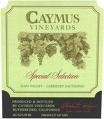 It didn't take long for a fair bit of feedback on the column I posted this week on the state of the wine industry. It didn't take long for a fair bit of feedback on the column I posted this week on the state of the wine industry.
There is indeed blood in the water, and some of it is the blood of innocents. Such as the prominent retailer who bought a palate of Caymus Special Selection Cabernet Sauvignon at more than $100 a bottle wholesale, before the distributor slashed the price in half. His wholesale cost was higher than the now widely seen retail price of $89 per bottle.
So he's underwater with dozens of cases of wine he can only sell at a loss.
Same as the wine merchant who bought 50 cases of Chateau Mouton at $600 a bottle wholesale, only to endure a long shipping delay as the market for expensive Bordeaux suffered a huge meltdown. By the time the Mouton arrived, his customers for it had vanished.
Add to that the reports I'm getting on Champagne sales heading into the important holiday season. "Dead in the water," one merchant told me. "Deader than dead."
 This begs the question, should I even bother to review the upper-end wines if there is so little interest? My answer is an unequivocal yes, because all of those wines will eventually find a home. Hence they deserve to go under the microscope. This begs the question, should I even bother to review the upper-end wines if there is so little interest? My answer is an unequivocal yes, because all of those wines will eventually find a home. Hence they deserve to go under the microscope.
"Every wine has a price at which it will sell," a veteran sales rep for a major distributor told me. "We simply have to find that price."
Winery execs are now preparing their budgets for 2010, and you can be sure that most are taking a hard look at their price structure. The bet here is that scores of them will hit the reset button. It's only a question of when, not if.
Posted by Robert Whitley at 11:07 AM
|
|
November 2, 2009
I’ve been writing about wine for 16 years now, and made my 1,000th site visit to a wine producer last week, so you might get the idea that all of this is getting a little stale. After all, if you turn over enough rocks, sooner or later you’ll cease to be surprised what you find beneath them. Right?
Well, that may happen to me someday, but the day seems pretty distant based on what I encountered in France’s Loire Valley last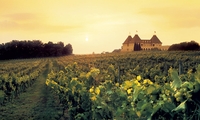 week. I’ve been to the Loire twice before, though only briefly on a side-trip to Sancerre in the first instance, along with a second trip that was truncated by a nasty case of food poisoning. Still, I love Loire wines, and taste a lot of them here in the States, so it wasn’t likely that I’d find anything especially surprising, right? week. I’ve been to the Loire twice before, though only briefly on a side-trip to Sancerre in the first instance, along with a second trip that was truncated by a nasty case of food poisoning. Still, I love Loire wines, and taste a lot of them here in the States, so it wasn’t likely that I’d find anything especially surprising, right?
Wrong. Really, seriously bloody wrong. I’ll devote my November WRO column to revelations from my week in the Loire (which followed the river from Muscadet country near the Atlantic all the way to Sancerre in central France), but I need to recount a case in point from the trip’s first site visit.
That first stop was a visit with André-Michel Brégon in the little town of 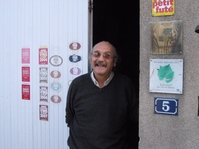 Gorges in the Muscadet district. I knew Brégon’s wines more by reputation than experience, and they have a very good reputation, but still: We’re talking Muscadet here, not Montrachet. Muscadet can be a very nice little wine, and it definitely has its role. That role is limited but not unimportant, namely, as an accompaniment to fresh, raw oysters, which are for me objects of quasi-religious culinary reverence. Gorges in the Muscadet district. I knew Brégon’s wines more by reputation than experience, and they have a very good reputation, but still: We’re talking Muscadet here, not Montrachet. Muscadet can be a very nice little wine, and it definitely has its role. That role is limited but not unimportant, namely, as an accompaniment to fresh, raw oysters, which are for me objects of quasi-religious culinary reverence.
But again, we’re talking Muscadet here, which means a simple little wine that is best slurped with those oysters when it is at its youngest and freshest, but then forgotten in favor of more serious stuff. Right?
Wrong again, though it took me a while to catch on. The first wine presented by the affable, slightly eccentric-seeming Brégon was from 2008, but it was a tank sample because he hasn’t even bottled the wine yet. Since the facility was a glorified garage that looks rather worse for years of wear, I was starting to think that this could be a very long morning. But the 2008 was very promising, and the bottled 2007 better still--vindicating Brégon’s approach--so things were looking up.
The 2006 continued the ascent, and the 2004 was even better, so my preconceptions were starting to crumble. The 2003 should have been dead as a doornail from that famously hot year, but it was amazingly fresh after spending a mind-boggling 45 months resting on its fine lees before bottling. The 2000 was delicious, and two different bottlings from 1999 were both terrific. I went slack-jawed when encountering a 1996 that showed no color change and no aromatic oxidation at all, but that had to be an anomaly stemming form the amazing 1996 vintage. Right?
Wrong yet again. The 1995 was fresh and delicious, and my note on the 1993 enthuses that these wines are somehow armored against the 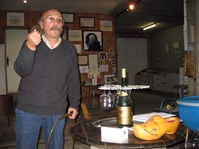 deleterious effects of oxygen. But Brégon wasn’t done taking me to school, as the 20 year-old 1989 showed the most exciting aromas of the entire lineup, including notes of lemon curd, apricots, mangoes, toasted nuts and caramel. And all of this out of a bottle that had been sealed with a crumbly cork that made André-Michel scowl with disapproval. deleterious effects of oxygen. But Brégon wasn’t done taking me to school, as the 20 year-old 1989 showed the most exciting aromas of the entire lineup, including notes of lemon curd, apricots, mangoes, toasted nuts and caramel. And all of this out of a bottle that had been sealed with a crumbly cork that made André-Michel scowl with disapproval.
The upshot of all of this is that the world of wine is an endless mine of surprises and wonders, and the Loire Valley is a particularly rich vein for those interested in digging them out. My intention is to keep digging at every chance I get.
Posted by Michael Franz at 9:33 AM
|
|
 |
|